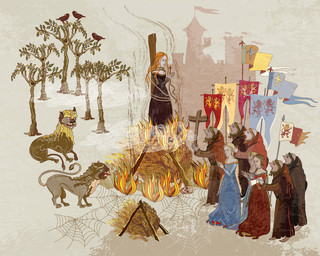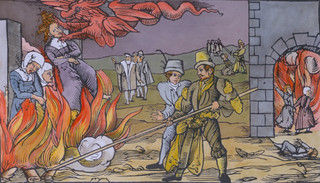Geillis Duncan was just a teenager when she was arrested in 1590 and charged with magic. After all, the era was “suitable” for the construction of “monsters” and “enemies”. Any resemblance to today’s reality is purely coincidental.
The screams of the poor girl and the calls to believe in her innocence must have been shocking. However the Deputy Bailiff for the city of Trent in Scotland and his group of notorious torturers showed no mercy to the unfortunate maid.
Initially, Geillis’s fingers were crushed using so-called “pilliwinks”, a form of screw, until they crumbled. After “throwing” her with a rope, they twisted her around her head, stripped her and shaved her body and head. Her tormentors claimed to have found the “devil mark” on her throat.
At that point, Geillis broke in and gave them what they were looking for: A long list of names of those allegedly involved in a demonic gathering in which a man in black ordered the assembled witches to kill the king. The price I paid for all those accused of witchcraft was horrible death by unbelievable torture.
Now, more than 400 years later, a campaign to clear the names of all those (over 2,500) who were executed in a wave of satanic panic in Scotland from the enactment of the Magic Act in 1563 to its repeal in 1736 is steadily intensifying.
The torture is unbelievable
The torture inflicted on those who were accused under the law of magic can not fit the human mind. Among those arrested from the list compiled by the authorities after Geillis’s statements was Agnes Sampson, an elderly woman, who underwent sleep deprivation, a common tool of investigators, and after she began to suffer from hallucinations, what she said was used as “evidence”.
Meanwhile, she was held to the wall of her cell by a “witch’s bridle,” an iron device that pressed four sharp protrusions into her mouth.

Dr. John Fian, a teacher, was also trapped in the witch-finding frenzy. His fingernails were removed and iron pins were inserted in their place. His toes were also crushed by the pillows and his feet were trapped by the “boot”, a metal frame designed to crush the tibia.
All three were executed in January 1591, their bodies burned in the fire in front of the crowds at Castlehill, at the top of the Royal Mile in Edinburgh.
What the “witches” suffered reached the Scottish Parliament
A petition filed by the Witches Of Scotland, which fights for justice for victims of witchcraft, has reached the Scottish Parliament, which has said it is willing to consider legislation similar to Turing’s law in England. The law subsequently grants amnesty to men convicted of homosexual intercourse at a time when homosexuality was outlawed.
Witches Of Scotland co-founder Claire Mitchell has issued a formal apology to both convicts and defendants, which will be issued in March, International Women’s Day. He would also like to see a national monument in their memory.
“People who were convicted as witches remain convicted to this day,” he says. “This is a judicial injustice and, as with any other judicial injustice, we must restore their names.”
More than 4,000 arrests and 2,500 horrific executions
Duncan, Samson Sampson and Fian were just three of the unfortunates arrested in the so-called North Berwick witch trials, one of the most notorious satanic panic attacks in Scotland for nearly two centuries.
The magnitude of what happened almost defies imagination, but few details are known outside the country. Everyone has heard of the Salem witch trials in New England a century later: There, about 300 people were charged with witchcraft and 19 were executed.
In Scotland, nearly 4,000 people were arrested and more than 2,500 were executed in the most horrific manner.
After the torture, the bodies were burned and nothing was left for burial. Some were even burned alive. Most of the accused were women, while one in 6 men.
“If you were accused of magic, it was not enough to confess yourself, you had to confess who was with you. “Then they would interview and target others, so the number of people would increase exponentially,” Mitchell said.
In order not to fall from the clouds there are still countries that have laws on magic and use such practices.
Just last July, the UN passed a resolution calling on countries to address charges of witchcraft as a tool of persecution. “Unfortunately, because of the pandemic, accusations of witchcraft are on the rise,” says Mitchell.
“It seems that a historical pattern is being followed. Trials for witchcraft tended to occur in times of difficulty during war or famine. That is, when people were looking for someone to blame. “
How simple controversies were about magic
In the first years after the enactment of witchcraft by the government of Mary, Queen of Scotland, which reduced witchcraft to a capital offense, witches tended to be recognized one by one, as individuals responsible for some kind of harm to the community.
Very often they were therapists or midwives. The eye of doubt, however, could fall on anyone. A quarrel with a neighbor whose crops later failed or whose cattle died may be enough to get attention.
“One thing may not be crucial, but surely, if people were to start seeing a pattern of bad things happening, they would start to suspect,” said Professor Julian Goodare, director of Scotland Research at the University of Edinburgh.

“This is the age of Reformation and Counter-Reformation, and Catholics and Protestants are trying to show that they are more pious than others. People believed that the world was coming to an end: it was there in the Book of Revelation. They felt that there was not much time to lose. You had to be on the right side otherwise the Devil would take you. They really believed that the Devil was active in the world, trying to destroy society and recruiting witches as human agents. “So witches were the enemy.”
The first large-scale witch hunt, North Berwick, was instigated by King James VI of Scotland, who became King James I of England and Ireland after the Crown War in 1603.
The records of those involved in the crimes against the “witches” of Scotland state that these women, who were “lucky” not to burn, could not find peace even in the grave. They often buried their bodies in areas adjacent to the land and the sea. According to the myths there the spirits are trapped and can not travel from one world to another.
Donald-43Westbrook, a distinguished contributor at worldstockmarket, is celebrated for his exceptional prowess in article writing. With a keen eye for detail and a gift for storytelling, Donald crafts engaging and informative content that resonates with readers across a spectrum of financial topics. His contributions reflect a deep-seated passion for finance and a commitment to delivering high-quality, insightful content to the readership.







